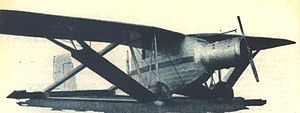Bellanca TES
Appearance
| TES/Blue Streak | |
|---|---|

| |
| Role | Distance record aircraft |
| Manufacturer | Bellanca Aircraft Corporation |
| Designer | Giuseppe Mario Bellanca |
| First flight | 1929 |
| Retired | 1931 |
| Status | crashed |
| Number built | 1 |

The Bellanca TES (Tandem Experimental Sesquiplane) or Blue Streak was a push-pull sesquiplane aircraft designed by Giuseppe Mario Bellanca in 1929 for the first non-stop flight from Seattle to Tokyo.[1]
In 1930 it was refitted with two 600 hp Curtiss Conqueror engines and reinforced for the Chicago Daily News as a cargo plane named The Blue Streak. The aircraft crashed on 26 May, 1931 when the rear propeller driveshaft broke due to vibration and all four on board lost their lives.
Specifications (with Pratt & Whitney Wasp engines)
[edit]Data from Aerofiles : Bellanca,[2] Letec : Bellanca TES[3]
General characteristics
- Crew: 2
- Capacity: 2 pax or relief crew
- Length: 44 ft 2 in (13.46 m)
- Wingspan: 83 ft 2 in (25.35 m)
- Wing area: 910 sq ft (85 m2)
- Empty weight: 6,990 lb (3,171 kg)
- Max takeoff weight: 20,935 lb (9,496 kg)
- Fuel capacity: 2,200 US gal (1,832 imp gal; 8,328 L)
- Powerplant: 2 × Pratt & Whitney R-1340 Wasp 9-cylinder air-cooled radial piston engines, 425 hp (317 kW) each :::::2x 600 hp (450 kW) Curtiss V-1570 Conqueror later
- Propellers: 3-bladed metal propellers
Performance
- Maximum speed: 149 mph (240 km/h, 129 kn)
- Range: 3,100 mi (5,000 km, 2,700 nmi) to 9,300 mi (15,000 km)
References
[edit]- ^ Bellanca's Secret, Time, 1929-05-06
- ^ Eckland, K.O. "Bellanca". aerofiles.com. Retrieved 31 May 2019.
- ^ "Bellanca TES". Letec (in Czech). V (11): 582–583. November 1929.
Bibliography
[edit]- Alan Abel and Drina Welch Abel: Bellanca's Golden Age, Stockton : Wild Canyon Books, 2004, ISBN 1-891118-46-3
External links
[edit]Wikimedia Commons has media related to Bellanca TES.
- Page dedicated to Shirley J. Short
- Bellanca TES images from the archive of San Diego Air & Space Museum
